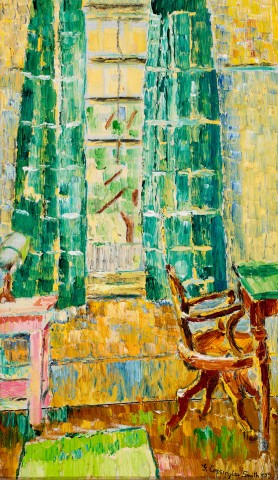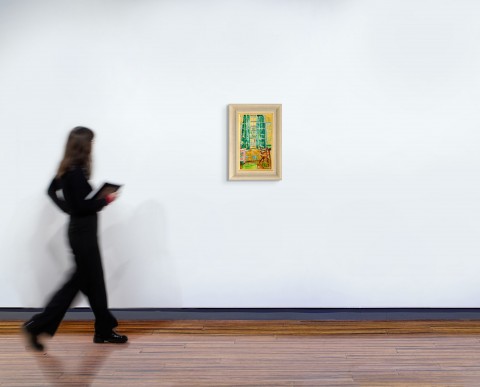INTERIOR WITH CURTAINS, 1959
GRACE COSSINGTON SMITH
oil on canvas on board
45.0 x 26.0 cm
signed and dated lower right: G. Cossington Smith 59
signed and inscribed with title on artist’s handwritten label verso: Interior with Curtains / Grace Cossington Smith
Estate of the artist
Thence by descent
Private collection, New South Wales
Deutscher~Menzies, Melbourne, 21 September 2005, lot 78
Private collection, Melbourne
Radiant with prismatic colour, Grace Cossington Smith’s intimate Interior with curtains, 1959 provides a glimpse of the artist’s immediate domestic sphere, which, although modest, hums with metaphysical and optical luxury. Withdrawing into ‘Cossington’, her family home in Turramurra in the 1950s to care for her ailing sister, Diddy, Cossington Smith’s pictorial world was quickly condensed into the interior views offered by the various rooms in her home. Animated by interesting pictorial devices such as pictures-within-pictures, views through windows and reflected through mirrors, Cossington Smith’s private interiors of the 1950s and 1960s would become her most mature and resolved paintings, confidently applying her iconic post-impressionist technique of form-in-colour.
Awash with the artist’s hallmark transcendent yellow light, Interior with curtains warmly depicts the corner of a bedroom. This small jewel of a painting follows a suite of window studies in pencil created in 1949 during Cossington Smith’s trip to Devonshire, the empty chairs facing a garden view silently becoming a portrait-in-absence of the cousin Frances Cranshaw she had been visiting.1 Closely related to a larger painting, Chair in the Room, 1960 (private collection), Interior with Curtains presents a simple composition dominated by a sculptural wooden chair, the harsh vertical surfaces softened by heavy dark green curtains. While the wooded view through the window is partially obscured by this drapery, the trees are further fractured by Cossington’s mosaic of square-tipped brushstrokes.
Deep in the house, the sunlit and airy view that Cossington Smith has presented here is tightly cropped. In contrast to larger compositions, there is no clever trickery of perspective involving oblique views through door frames and mirrors. Nevertheless, despite the simplicity of this composition, the artist still plays with the idea of concealment and containment, the vibrating surface of her painting creating a sensation of restlessness noted by the critic Paul Haefliger.2 Although the light within the house was quite subdued, the violent luminosity and touches of pure high-key colour of Cossington Smith’s interiors describe an artist at the height of her powers, boldly experimenting with subject matter so familiar to her.
Grace Cossington Smith’s interiors continued throughout the 1960s, shining brighter as the artist aged. In 1969, her fame was crystallising, with her work included in Mervyn Horton’s Present Day Art in Australia. In this publication, the artist restated her beliefs, giving the interpretative keys to her read her paintings: ’All form – landscape, interiors, still life, flowers, animals, people – has an inarticulate grace and beauty; painting to me is expressing this form in colour — colour vibrant with light — but containing this other, silent quality which is unconscious, and belongs to all things created.’3
1. South Lodge, Rochester, 1949, pencil on paper, National Gallery of Australia, see: Thomas, D., Grace Cossington Smith: A Life, from the drawings in the collection of the National Gallery of Australia, National Gallery of Australia, Canberra, 1993, p. 53
2. See Hart, D., Grace Cossington Smith, National Gallery of Australia, Canberra, 2005, p. 79
3. Horton, M. (ed.), Present Day Art in Australia, Ure Smith, Sydney, 1969, p. 203
LUCIE REEVES-SMITH


